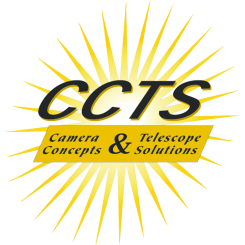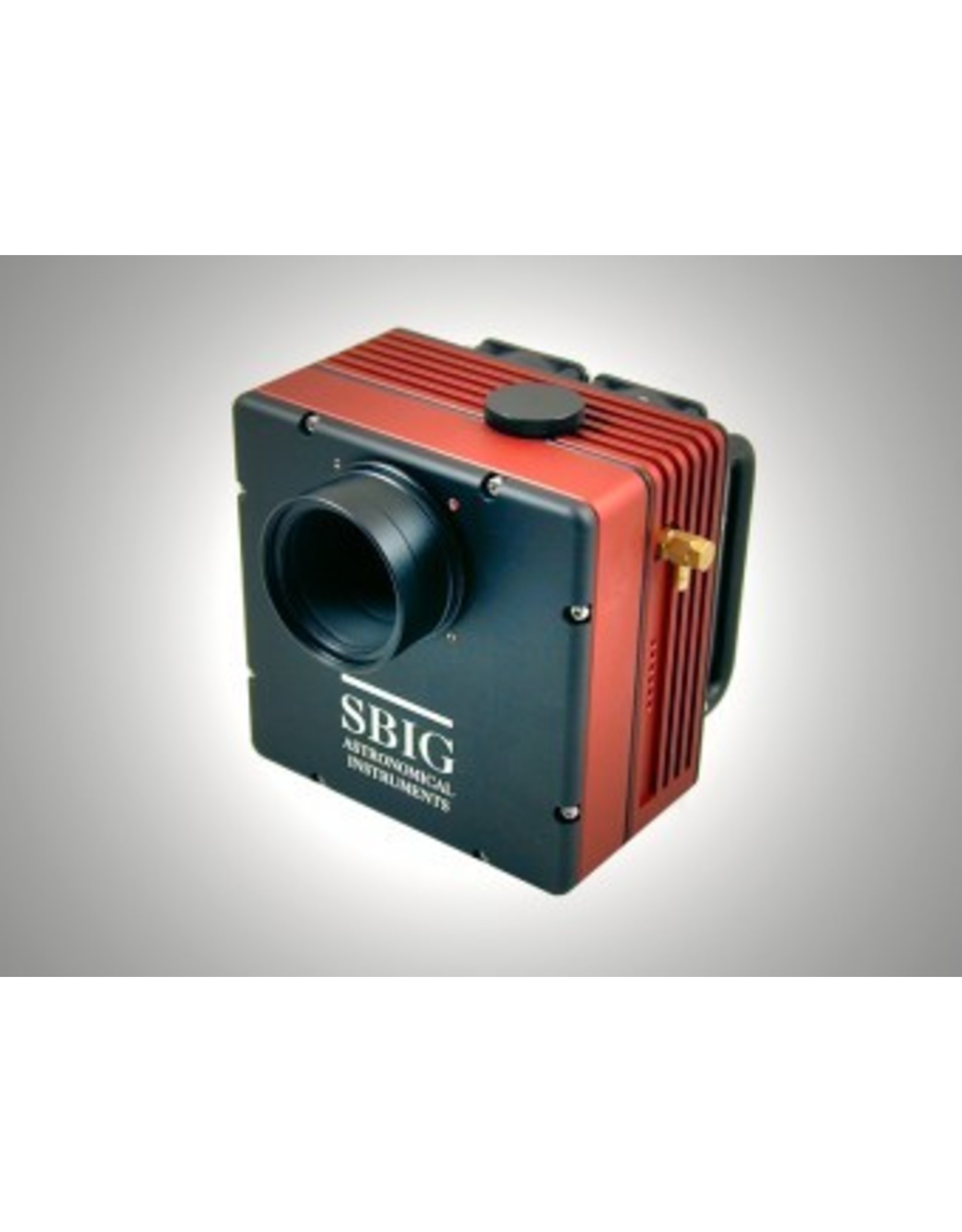SBIG STT-3200ME Monochrome CCD Camera
| Article number: | STT-3200ME |
| Availability: | More on the Way to us |
| Delivery time: | Extended Shipping Lead Time |
|
No compromises. Our mid-sized STT Series cameras offer features and specifications found in no other astro camera - of any size. Drawing on all of our previous experience and the best of each of our previous designs over the years, the STT represents the culmination of everything that the amateur has asked for in an imaging system, packed into a 4.9 x 4.9 x 2.9 inch body. Standard features include: Two-stage cooling with a temperature delta greater than -50C with air only; water cooling ready; USB 2.0 and Ethernet on every camera; full frame buffer; fast low-noise readout of an 8.3Mp CCD in less than one second; MAR coated sapphire chamber window; internal user selectable automatic image processing; self-guiding in front of filters; remote guide head support; optional adaptive optics; and more. [Read a comparison of the STT-8300 and STF-8300] Click here to read the full review of the STT-8300 in Sky & Telescope Magazine Compare these STT features with any other camera: • Ethernet and USB 2.0
Micron-Precision Filter Wheel / Guider A new filter wheel design for the STT series sets it apart from other designs. The carousel holds eight 36mm filters and inserts are available for 1.25" filters. Two new unique features make this an imager's delight: First, the design incorporates a self-guiding CCD in the filter wheel cover so that light from the guide star is captured before passing through the filters. An optional filter wheel cover is available for wide angle imaging with Nikon or Canon 35mm camera lenses, or for anyone who does not need or want the built-in self-guiding. Full sets of 36mm LRGB and Narrowband filters by Astrodon, Baader Planetarium and Astronomik are available for unvignetted imaging at any f/ratio. The second unique feature of the STT filter wheel is a positive centering mechanism that precisely re-positions and firmly holds filters in exactly the same position over the CCD every time, regardless of a loss of power or intervening movement of the filter wheel. In our tests of the new design, using an STT-8300, the re-positioning of the filters was accurate to better than 5.4 microns after several complete rotations of the filter carousel. This degree of precision means that flat fields taken after the filter has moved and returned are accurate to a single pixel. An example of the improvement in flat fields with this kind of precision is demonstrated in the comparison images below.
The image at left, above, is a large opaque spot on a filter in STT filter wheel. The filter carousel was rotated several times before the filter was moved back into the optical path and a flat field was taken. The image at right shows the resulting flat field image.
Even-Illumination Shutter A mechanical shutter is included to facilitate dark frames. This is a necessity for anyone operating remotely; even if remotely means a few feet away from the telescope. Since the early days of the original ST-7 camera, SBIG has been providing even-illumination shutters in our cameras, something not found in the majority of other cameras made for astrophotography. "Even-illumination" means that the shutter mechanism is designed to open and close in such a manner that it does not change the proportion of light falling on the sensor due to the shape or motion of the shutter itself. This is what one finds for instance with an iris type of shutter that opens-up starting at the center and closes over the center last. In the STT-8300 we use a simple and very robust shutter wheel with a fan-shaped aperture of the same design that we have employed in the ST series cameras for the past 15 years. The STT-8300 shutter sweeps over the CCD without leaving any area of the sensor exposed for a different period of time than any other area. Another benefit of the rotating disk type of shutter is that it has only one moving part - the motor. These motors are extremely reliable and can operate for millions of exposures without failure. In 15 years with thousands of cameras in the field taking millions of exposures, this shutter design has proven itself better than we can describe. Our design is accurate, proven and reliable. Even-illumination shutters are also referred to as photometric shutters because they produce flat frames of photometric quality. This is extremely important when taking twilight flats or any flat field image using short exposure times. The effect is demonstrated in the twilight flat field images shown below:
The left image shows a twilight flat field image taken with a camera using an iris type shutter. The right image is a flat field image taken under the same conditions using our even-illumination type shutter. Efficient 2-Stage TE cooling The STT uses two-stage TE cooling, twin variable-speed fans and a highly efficient pin fin array heat sink that has proven itself in the STX design. Pin fin heat sinks are more expensive than typical parallel fin type heat sinks, but offer more efficient heat dissipation in a given space. In our tests of prototype models, the cameras reached an average delta greater than -50C in five minutes and an average maximum delta of -57C in less than 10 minutes using air cooling only. And, while is should not be necessary to use water cooling in most circumstances, if it should be desired, the STT series cameras include water cooling capability as standard equipment. It is not necessary to buy an expensive add-on or separate back. Simply supply water to the adjustable fixtures on the side of the camera body to obtain further cooling or to run the TE cooler without the fans. Exceptionally Low Dark Current The KAF-8300 CCD has very low dark current, even at room temperature. Cooling the CCD reduces the dark current by 50% for every drop of 5.8 degrees C of cooling that is applied. Kodak specifies a dark current of less than 200 electrons per pixel per second at +60 degrees C. Extrapolating we calculate that at -15C the dark current is approximately 0.02e-. Our tests of the 8300 CCD in production cameras confirm this extraordinarily low dark current at typical operating temperatures.
High Quantum Efficiency Another desirable characteristic of the KAF-8300 CCD is its relatively high Quantum Efficiency (QE). Microlens technology is used to focus more light on the sensitive area of each pixel, increasing the effective QE of the 8300. Many nebulas emit a great portion of their light in the red portion of the spectrum, particularly at 656nm, the wavelength of H-alpha light. Other objects such as stars and galaxies emit a great deal of energy in the near IR. According to the KAF-8300 spectral characteristics, this CCD's sensitivity is spread well across the visible portion of the spectrum and into the near IR with a peak of nearly 60% at 550nm and still 50% at 656nm. It is as sensitive at 850nm as it is at 350nm. This is quite a broad range and explains the CCDs popularity (and success) in astro-imaging. Standard (ST-4 pin compatible) Autoguider Output Port The guider port on the STT-8300 is the same as on our other cameras, using a modular telephone type 6-pin jack to connect the STT-8300 to the user's mount when using the camera as an autoguider. The internal relays used in the STT-8300 design are opto-isolated, so that no external relay box is required with any mount if the camera is being used as an autoguider or if it is being used to control the telescope in Track & Accumulate mode. 12VDC Operation The STT Series cameras come with its own universal AC power supply. This supply will operate from 100-240VAC and provides 12VDC at 3.5A to the camera. The STT-8300 also has a built-in voltage regulator and can be powered directly from any unregulated 12V (10 - 14 volts) source such as a battery for operation in the field. Included Carrying Case A Pelican Storm Case is included with each camera. Models STT-8300M is the standard model, with KAF-8300 monochrome image sensor. We also offer the STT-1603 and STT-3200. These cameras are built-to-order; please allow 8 weeks for delivery.
STT-3200MEPlease note this model is available built-to-order. Please allow 8 weeks for delivery. Quantum Efficiency
Typical Specifications
|


